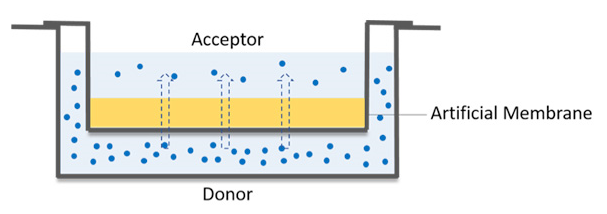A major obstacle to successful drugs is their permeability through biomembranes, which may determine the extent of oral absorption, biodistribution, and, consequently, the target tissues uptake. At present, high-throughput screening (HTS) for compounds with reasonable membrane permeability has become a key goal in the early stages of drug discovery and development process. One of the most interesting techniques emerging as an HTS tool is the in vitro parallel artificial membrane permeability assay (PAMPA). In PAMPA, 2 well plates are used to form a "sandwich"-like structure: a donor plate with porous membrane wells that are submerged in the wells of receiver plate. The porous membrane is coated with a lipid solution (initially lecithin in dodecane) to form a bilayer to mimic the biological membrane. The donor wells contain the drug in an aqueous buffer solution, and the receiver wells contain only buffer solution. Drugs that are able to permeate the cell membrane will passively diffuse into the receiver wells (Fig. 1). By changing the lipid composition, different membranes can be simulated, and PAMPA has since been modified to predict the permeability of skin, retina and blood-brain barrier.
PAMPA provides a simplified approach to permeability by addressing just a single transport mechanism. This avoids the complexities of active transport and metabolism, enabling ranking of the compounds on a single permeability factor.
 Figure 1. The schematic diagram of PAMPA experimental setup.
Figure 1. The schematic diagram of PAMPA experimental setup.
PAMPA Models Available at Creative Bioarray
- Original PAMPA – The lipid solution consists of 10% lecithin in dodecane.
- DOPC-PAMPA – The lipid solution consists of 2% DOPC in dodecane.
- HDM-PAMPA – The lipid solution is 100% hexadecane.
- Bio-mimetic PAMPA (BM-PAMPA) – The lipid solution consists of a mixture of PC, PE, PS, PI and cholesterol in an organic solvent.
- Double-Sink™ PAMPA (DS-PAMPA) – The lipid solution consists of 20% dodecane solution of a phospholipid mixture and the acceptor solution contains a surfactant mixture.
Using Creative Bioarray's ADME screening services is the fastest and most cost-effective way to get permeability predictions for your compounds. For more detailed information, please feel free to contact us or sent us an inquiry directly.
References
- Fortuna A. et al.; Optimization of a parallel artificial membrane permeability assay for the fast and simultaneous prediction of human intestinal absorption and plasma protein binding of drug candidates: application to Dibenz[b,f]azepine-5-Carboxamide derivatives. Journal of Pharmaceutical Sciences, 2012, 101(2): 530-540.
- Clemons K. et al.; Parallel artificial membrane permeability assay for blood–brain permeability determination of illicit drugs and synthetic analogues. Science & Justice, 2014, 54(5): 351-355.